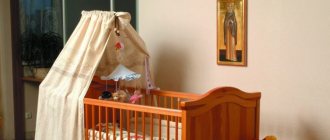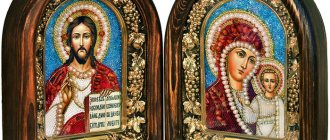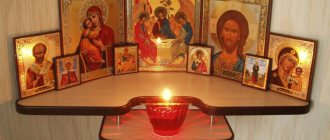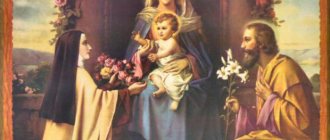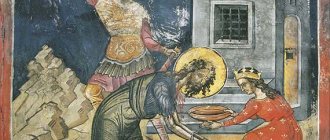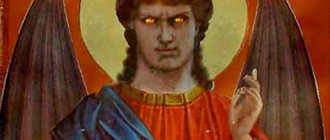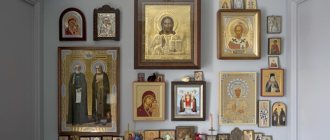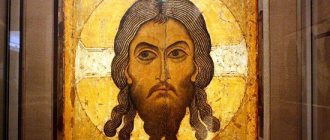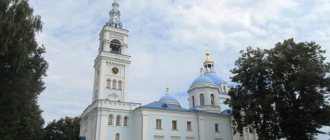The Last Judgment of God,
Savior, the True Vine, the Burning Bush
,
the Life-Giving Spring
,
the Tree of Jesse.
Go to Table of Contents.
Please note: images are clickable.
The Last Judgment of God.
The spiritual image on this icon is one of the most significant and significant in Orthodoxy. The plot of this icon reflects the Biblical prediction about the second coming of our Lord Jesus Christ, about the resurrection of the dead and the Last Judgment of the Lord, in which sinners and righteous will be separated, each will be rewarded according to his deeds and his path will be determined, some to heaven and some to hell. This spiritual image amazes with its genius, beauty, number of large and small details, as well as the persons involved, which are mentioned in the Holy Scriptures. Christian chronicles have conveyed information to this day that says that this image appeared approximately in the 4th century after the Nativity of Christ. Many historians claim that the first image was not as rich as the modern one, so it was constantly improved, and only in the 8th century, the icon “The Last Judgment of God” became canonical. According to church belief, this icon came to Holy Rus' around the 10th century, and immediately became significant for Russian Orthodox believers, since the inhabitants of Rus' have always revered Scripture and the images depicted from it. Before the spiritual image on the icon “The Last Judgment of God,” it is appropriate to offer prayers, first of all, for the forgiveness of sins committed consciously and unconsciously, and also to ask for admonition and for help in resisting worldly temptations. It is customary to pray to the image on the bottom icon for repentance, since only repentance can save the soul and open the Kingdom of Heaven for the believer. The Church of Christ remembers the Last Judgment of the Lord for a whole week, which begins fourteen days before the Great Orthodox Lent.
Sleeping with eyes open
0
For those unfamiliar with the canons of icon painting, “Savior the Watchful Eye” is a very unusual copy. It depicts Christ as a young man who is either resting his face out of boredom, or is about to take a nap.
In fact, Jesus in this image is already asleep, but he sleeps with his eyes open, which is an allusion to the lion. In the Middle Ages, it was believed that a lion sleeps this way. The origins of the image come from just a few lines in the Bible, where Jesus is called “the lion of the tribe of Judah” (that is, a brave man). In iconography, this image appeared in Byzantium, and then spread to Rus'.
Spas Loza Istinnaya.
The plot of the icon is based on the words of our Lord Jesus Christ from the Holy Scripture: “I am the true vine, and My Father is the vinedresser.” Grapes are a symbol of wisdom and greatness, and most importantly, they are a symbol of life, therefore the Lord in this icon is surrounded by a grapevine, symbolizing eternal life, and therefore the immortality of the soul. The Savior knows everything about everyone, he always hears the prayer of a believer, therefore he sends his gracious help. At the same time, Christ helps to understand and realize that no matter what earthly values and wealth collected by people, they are all perishable and empty in comparison with spiritual values, therefore, before this icon it is appropriate to offer prayers for repentance and strengthening in the Christian faith. In addition, in front of the icon of Jesus Christ “True Savior Vine,” you can pray for all the difficulties and problems that trouble your soul and heart, and, of course, for the healing of bodily ailments, mental wounds, and for good health for many years, because in During his earthly life, the Savior demonstrated to people that nothing was impossible for him and showed many miracles. For the icon of the Lord “True Savior Vine”, there is no special day for its veneration, since the Lord must always be remembered, prayerfully turn to his image with your problems and aspirations, thank him for the help provided, and for what we have, and then the Savior will send what a person truly needs.
Our Lady with Three Arms
0
The name speaks for itself: the Mother of God is depicted with three hands. According to legend, the story behind this image took place in the 8th century in Byzantium and is associated with an episode from the life of St. John of Damascus.
He lived in Syria, came from a noble Christian family and was a prominent official in the caliphate. At that time, iconoclasm was just gaining momentum - a movement sanctioned by the authorities against the veneration of icons and the destruction of all other objects of worship. As a zealous Christian, Damascene did not stand aside and sent a message of protest to the Byzantine Emperor Leo III. It quickly spread throughout the empire and infuriated the emperor, but he could not do anything with the Syrian citizen. Thus was born the plan to frame Damascene. A letter was written on his behalf in which Damascene allegedly calls on the Byzantine ruler to attack Syria and rid it of the caliphate. The fake was handed over to the caliph, and he ordered Damascus's hand to be cut off. As a warning, the hand was displayed in the main square of the city. The slandered man prayed all night before the image of the Mother of God - and the severed hand miraculously grew back. Soon, according to believers, the first icon of the Mother of God appeared with a silver third hand attached to it. But over time, a tradition arose of simply painting it on with paint.
Mother of God "Burning Bush".
The Burning Bush - commemorates the unconventional conception of the Savior of this world from the Holy Spirit, and also shows and designates the Mother of God who was born on a sinful earth, but not subject to sin. This spiritual image of the Mother of God is unusual and unique; it differs from the image of the Mother of God familiar to Christians. According to surviving chronicles, this picturesque image first saw the light of day on Greek soil back in 1100. The master or masters who created this icon, unfortunately, remained unknown. Before this icon, you can pray in the same way as before the usual images of the Mother of God on the “Burning Bush” icons, namely: Pray to the Mother of God for help in everyday affairs, ask to strengthen your faith and send good health. This icon protects against fires, thunder and lightning, and protects the homes of Christians from intruders, villains and evil spirits. In Russia, the icon is revered as the heavenly patroness of Russian firefighters. Church celebrations in honor of the Burning Bush icon of the Mother of God take place on September 17.
Why were mixed-hypostatic icons banned?
In Europe, mixed-hypostatic icons were banned at the beginning of the 16th century. This decision was made at the Council of Trent. In 1628, by decree of Pope Urban VIII, the practice of painting mixed-hypostatic icons of the Trinity was again prohibited. All such icons were declared blasphemous and heretical. After this, almost all mixed-hypostatic icons in Europe were burned. And those that have somehow miraculously survived can be seen in museums today. For example, in the Austrian folk art museum in Tyrol or above the entrance to a small church in Romania. In Russia, the ban on mixed-hypostatic icons was introduced in 1764 by the Holy Synod of the Russian Orthodox Church.
The Holy Synod also recognized the unusual icons of the Holy Trinity as heretical. The decree prescribed that “all absurd and strange obscenities should be suppressed in icon images.” Because of this decree, the mixed-hypostatic icon of the Holy Trinity, which the church called “the likeness of Hellenic (Hellenic) gods,” was removed from the gates of the Annunciation Cathedral in Tyumen.
Despite the decree of the Holy Synod, this forbidden icon was not destroyed. Just as some other mixed-hypostatic icons that were located in churches remote from the capital were not destroyed. A similar fate befell the three-faced icons, painted using a unique technology.
Mother of God "Life-Giving Spring".
The miraculous icon of the Most Holy Theotokos “Life-Giving Spring” gained worldwide fame after it granted healing to all the infirm from the most complex physical ailments and spiritual wounds. The name of the icon speaks for itself, and personifies the salvation of the human soul, both in the literal and philosophical sense, because the Mother of God herself has become a life-giving source for all believers. Before this icon it is appropriate to offer prayers for deliverance from passions and addictions, especially alcohol and drugs. People turn to the spiritual image of the Mother of God in grief and sorrow, which burden the soul, which certainly leads to deprivation of vitality. The Mother of God will always hear the prayer of a believer asking for intercession from worldly temptations and earthly temptations, and will protect a Christian from evil demons who are trying with all their might to take possession of the soul of a believer in order to turn him away from worshiping the Lord. In Russia there are more than a hundred Orthodox churches, many chapels and monastic monasteries, named after the icon of the Most Holy Theotokos “Life-Giving Spring”. The Orthodox Church celebrates celebrations in honor of this icon on every Friday of Easter week.
Unique technology for making icons
Three-faced icon “Annunciation. Lord of Hosts"
The unity of the Holy Trinity found another interesting reflection in iconography. Thus, in the “Alexandrovskaya Sloboda” museum-reserve in the Vladimir region one could previously see one very unusual icon “The Annunciation. Lord of Hosts,” dated 1791. When the position of the viewer changed relative to the icon, the image on it also changed. An unknown artist depicted three faces on 16 thin wooden planks, vertically mounted in a frame. And for this he had to work hard.
The icon painter applied the images onto thin primed plates and pressed them against each other so that they formed a single plane. Then he wrote one face on one side, and a second one on the other. The artist painted the third face directly on wooden canvas. The master installed the boards with the other two faces into special grooves on the frame, strictly observing the distance between them. A similar technology can be found today on some billboards, where the image changes when triangular plates move.
Tree of Jesse.
The unique and somewhat unusual icon of the Most Holy Theotokos “Tree of Jesse” is a very rare icon, which, in the line of the Most Holy Theotokos, the Virgin Mary, depicts the genealogy of our Lord Jesus Christ. Prophecy from the books of Holy Scripture tells us that the Savior of this world will come from the royal family of David, the son of Jesse. The image on this icon shows us Jesse lying on the ground, from which his tree grows, where the ancestors of Jesus Christ are depicted. It is believed that the icon “Tree of Jesse” was created by an unknown icon painter in Greece, its original name was “Mirovlitis”. Currently, the original icon is in the monastic monastery of St. Nicholas the Wonderworker, which is located on the Greek island of Andres. Before the spiritual image on this icon, it is appropriate to offer prayers for strengthening in faith, and for help in everyday affairs. In honor of the icon of the Mother of God “Tree of Jesse”, the Church of Christ holds celebrations once a year - on July 15.
Continuation of the article: part 4.
Many-faced icon
0
It was even worse for the icons with the image of the three-faced Christ. The Roman Catholic Church condemned such images a century earlier than the Orthodox Church did. “Uncanonical and ugly,” declared the Synod in 1764, and banned the image. However, news did not reach the remote corners of the country quickly, and many-faced icons continued to appear in parishes.
One head, three faces, four eyes - this frightening image was just one of the visual representations of the dogma of the Trinity (father, son and holy spirit). Traditionally they were depicted as three identical figures with the face of Christ, but the idea was developed in this way. On some icons, the Trinity generally had one body, but three heads with identical faces.
RARE AND REVERED ICONS
HERE ARE SOME FACTS OF THEIR “LIFE” ICONS OF THE OLD BELIEVERS. IT IS USEFUL TO KNOW THIS AND DISTINGUISH BETWEEN POST-REFORM ICONOGRAPHY AND PRE-REFORM:
The Old Believer icon as a whole continues the traditions of the Old Russian icon, since the Old Believers believe that it was not they who broke away from Orthodoxy, but that it was the official church that fell away from the original Old Orthodox faith, of which they are the defenders. However, only those that diverged in their tradition from official Orthodoxy can be classified as strictly Old Believer icons.
Plot features:
1. Saved the Good Silence. It depicts an angel with his arms crossed on his chest (as a communicant), dressed in a royal tunic and wearing the eight-pointed crown of the glory of God the Father. On both sides next to the crown are the inscriptions “IC” below “Good” and “XC” below “silence.” The non-canonical depiction of Christ in the form of “created” nature - an angel - is prohibited in the Russian Orthodox Church. 2. Spas Wet Brad - an image of the Savior with a wedge-shaped beard and a left eye larger than the right. 3. Spas the Ardent Eye - an image of the Savior with an elongated head, a dark face without a halo in blue-blue clothes. 4. Our Lady of Fire. 5. Martyr Christopher the Pseglavets. His Icons “with a dog’s head,” along with some other “controversial” iconographic subjects, were officially prohibited by order of the Holy Synod of 1722 as “contrary to nature, history and the truth itself.” The Old Believers continued (and still continue) to venerate Christopher Cynocephalus, and the ban on the “dominant church” only confirmed and strengthened this veneration. 6. St. Nicholas the Repulsive - the image of St. Nicholas of Myra of Lycia, the miracle worker with pupils squinting to the left. 7. Hieromartyr Avvakum, 8. Nun Theodora (boyar Morozova) 9. Andrei Denisov - one of the founders of the Vygoretsk non-priest monastery. 10. Like other Orthodox Christians, Old Believers revered icons dedicated to the Last Judgment and local saints: Zosima and Savvaty of Solovetsky, Varlaam of Khutyn, Alexander Oshevensky, Sergius of Radonezh.
The abundance of inscriptions in the margins is a characteristic feature of Old Believer icons. Wooden icons of Old Believers are usually characterized by dark faces. The Old Believers were also characterized by copper and tin “cast icons.” In the 18th century, official Orthodoxy banned the production of such icons. Even before the church schism, there were changes in Russian icon painting caused by the influence of Western European painting. Old Believers actively opposed innovations, defending the tradition of Russian and Byzantine icons. In the polemical writings of Archpriest Avvakum on icon painting, the Western (Catholic) origin of the “new” icons was pointed out and the “lifelikeness” in the works of contemporary icon painters was harshly criticized. In the “ruling” Russian Orthodox Church, from the end of the 17th century, a decline in icon painting began, ending in the almost complete oblivion of the canonical icon by the 19th century. The Old Believers collected “pre-schism” icons, considering the “new” ones to be “graceless.” The icons of Andrei Rublev were especially valued, since Stoglav cited his work as a model. The collection of ancient icons by Old Believers gave rise to an entire industry of counterfeit “antique” (counterfeit) icons. The Old Believers were the main (and probably the only) experts in icon painting and iconography in awakening interest in Russian icon painting at the turn of the 19th-20th centuries, during the so-called. "Discovery of the Icon" In large Old Believer centers, independent schools of icon painting developed, including schools of copper-cast icons. Copper-cast icons of small size, easily reproduced from a model, were convenient both in production and in use by Old Believers persecuted by secular and ecclesiastical authorities. The Synod of the Russian Orthodox Church in the 18th century banned the use of cast icons in the “official” church. “Pomeranian Answers” collected and analyzed extensive iconographic material; it was one of the first comparative iconographic studies in Russia.
Iconographic and plot features:
First of all, it is necessary to note the common features of all Old Believer icons, which make it possible to separate them (though not always) from works of official church art:
1. As is known, one of the most important differences between the Old Believers and the Nikonians was the issue of finger formation. The official church in the post-reform period prohibited the depiction of two-fingered folds on icons. On the contrary, double-fingering is ubiquitous in Old Believer fine art.
2. Old Believers and Nikonians differed in the inscription of the abbreviation of the name of Jesus Christ. Old Believers reject Nikon's innovation - the spelling of the name of Christ as Jesus and, consequently, the inscription on the icons “IIS. HS." The only correct spelling of the name of Christ is proclaimed as Jesus and the abbreviation “IC.” HS." (which is an ancient and original Slavic form of pronunciation of the name of the Savior). 3. The difference between the symbols of the evangelists on Old Believers and Nikonian icons: the symbol of Mark among the Old Believers is an eagle, and John is a lion, on Orthodox icons of the post-Nikonian period - vice versa. In addition, Old Believers icon painters continued, in accordance with the ancient Russian tradition, to depict evangelists in the form of animals, which was categorically prohibited by the Orthodox Church in 1722. Along with double fingers, one of the significant disagreements between the Old Believers and the official church was the question of the shape of the cross. On all Old Believer icons in the hands of saints, on the domes of churches, only eight-pointed crosses are always depicted. We will never meet four-pointed or six-pointed ones here. Old Believer icons also cannot contain images of new saints canonized by the Russian Orthodox Church after the schism, new images of the Mother of God and new versions of traditional subjects (for example, the Resurrection of Christ is depicted only in the form of the Descent into Hell). In the icon painting workshops, the canons and traditions of Old Russian icon painting professed by the Old Believers were sacredly observed, which, in turn, were determined by the circle of Orthodox models that had developed by the middle of the 17th century. It was in the Old Believer environment that there was a strong orientation towards ancient models, most of which have come down to us in later repetitions. To some extent, folk icons also reflect a certain iconographic repertoire. Old Believers of different persuasions had different attitudes towards the icon. In one sense, different communities (pochinki, villages and hamlets) had their own ideas about which icons to worship and how. When considering popular piety, it should be remembered that in reality the religiosity of the Old Believers was very integral, fused with their way of life. An indispensable accessory of any hut of the Old Believers, for example, in the Nizhny Novgorod and Vyatka provinces, were icons, as evidenced by expeditionary and archival materials. There were from 5 to 20 images in the house at the same time. It is difficult to determine which icons were encountered more often. It depended on taste and the circumstances of life at home and, of course, on belonging to a certain denomination. In the houses of Old Believers of the priestly persuasion of the Austrian consensus, the most common icons of the following subjects: “The Trinity of the Old Testament in Genesis” (in two editions, the most common version is “Hospitality of Abraham and Sarah”), “Savior Almighty”, “King the King” (“Savior the Great Bishop "), "Image of the Savior Not Made by Hands" in a special version - with two (sometimes four) angels holding the ends of the ubrus. Of the Mother of God icons, the most revered among local Old Believers are still “Hodegetria of Smolensk”, “The Sign”, “The Intercession”, “Three-Handed”, “Kazan”, “Fire-shaped”, “Burning Bush”, “Do not cry for me, Mother”. Akathists and cathedrals of miraculous Mother of God icons are widely found in homes. On the margins of brownie icons, usually of the Mother of God, a life-size image of selected saints is given. Particularly noted is the patronal nature of the selection of saints named after family members, with the obligatory inclusion of a Guardian Angel among them. From Tue. floor. XIX century 6-8 figures of saints are often depicted in the margins. Such icons serve as home iconostases for their owners; in everyday life they are often called that. The name “house iconostasis” was also assigned to icons with cast insets. In such icons, there is always a cross (altar or icon case) in the center, around which cast images and multi-leaf folds are placed. Casting in combination with painting was preferred by the Old Believers of the chapel persuasion. In every home you can find several icons of the Savior, the Mother of God, images of the most revered saints - St. St. Nicholas the Wonderworker, martyr. John the Warrior, Martyr Paraskovia, Martyr Catherine and Barbara, as well as Menaion icons and the Twelfth Feasts. The Fedoseevites especially venerate Saint Paisius and pray to him for those who died without repentance, but they do not mention the name of the deceased; They also turn to the holy martyr Huar; they also pray to him when a person died without repentance. In similar cases, they pray to St. Thecla, but only for the repose of women. Among the Pomeranian Old Believers there is an image of John the Theologian with a finger at his mouth (the icon “John the Theologian in Silence”). They interpret this plot as evidence of the impossibility of knowing in advance the time of the “end of the world.” The first Moscow Metropolitan Peter, the mediator between the Mother of God and the Russian people, was especially revered among the Old Believers. Our Lady and Metropolitan Peter were revered as protectors and guardians of true Christian piety. Their images can be found on images with selected saints and in other compositions. In the houses of the Old Believers there are a large number of icons of the Mother of God from the 19th and 20th centuries. Prayer texts were also dedicated to the Mother of God - canons, akathists, troparia and services for the feasts of the Mother of God, which were supplemented with colored folklore fiction, legendary fiction, apocryphal tales, and narratives of visions. The extremely popular apocrypha “The Virgin Mary’s Walk through Torment” and “The Virgin Mary’s Dream” were found in handwritten Prologues and Triodions, kept in the Old Believer environment. In the XIX-early XX century Among the Old Believers, the icon “Our Lady of Tikhvin” was especially revered as painted by the Apostle Luke and being an assistant in the establishment of monasteries, the guardian of true Orthodoxy. Often the image of the Mother of God is accompanied by an ornament of climbing stems and flowers - symbols of the Gardens of Eden, which speaks of the traditional perception of the Mother of God as the Queen of Heaven of the heavenly abodes of the Most High God. “The Tale of the Tikhvin Icon of the Mother of God,” being one of the most famous stories about the movement of Christian shrines to Rus', could not help but come to the attention of the Old Believers. Stories of this kind, created in Rus', received the significance of historical evidence in favor of the fact that only Russian Orthodoxy preserved ancient Christian traditions, and this evidence is very important, since the very transfer of shrines in such legends, as a rule, occurred miraculously, therefore, by God's providence. The theme of the continuity of ancient Christianity by Russian Orthodoxy was one of the central ones for the Old Believers, since the idea of such continuity, which distinguished the Russian Church from other Christian churches, and the understanding in this regard of the need to preserve the “Russian faith” ultimately led to a sharp clash between the Old Believers and the official church authorities, who introduced many changes into established church forms, which were perceived by the Old Believers as “damage.” The identification of the Tikhvin icon with the icon painted by the Evangelist Luke made it possible to consider the folding of the baby Jesus depicted on it as a primary argument in favor of antiquity and, therefore, the truth of the double finger. The special role of this evidence was also determined by the fact that the icon image could serve as evidence in support of the Old Believer opinion about the formation of the finger for illiterate people. The official church interpreted the sign of Jesus on the Tikhvin icon as a nomenclature. In the prayer houses and private houses of the “zealots of ancient piety” you can find icons of the Vladimir, Kazan, Iveron, Shuya Mothers, as well as the “Sorrowful Mother of God”. The Old Believers, venerating the “Sorrowful Mother of God,” performed irmos for her, calling on her in sorrow and as a savior from slander. In the popular consciousness, the cult of the Mother of God was given first place among the “saving” and “healing” miracles that were expected from the icons of saints. But the nature of the expected “miracles” in each village could be different. However, the desire to see not the heavenly, but precisely the earthly presence of the Mother of God, the inclusion of icons of the Mother of God in the rhythm of one’s life and everyday worries, unites the views of different communities and schools of thought among the “zealots of ancient piety.” On numerous Old Believer icons of the Lord Almighty, the Heavenly King seemed to “replace” the Orthodox king in a graceless world. The prevalence of the iconography of the Almighty among the people is similar to the prevalence in spiritual verses of calling Christ “King of Heaven.” Since the real world was perceived as the kingdom of Satan, it was also perceived as a place of torment that required a speedy trial. Mostly among the Old Believers there are icons of the Lord Pantocrator, made “in the manner of Rublev.” The Savior was depicted in a traditional three-quarter turn, with a two-fingered blessing, holding the open Gospel with his left hand. Among the chosen saints, St. Nicholas the Wonderworker, John the Theologian “in silence”, John the Baptist, the prophet Elijah in the “fiery ascension”, Archangel Michael, represented as the “Terrible Powers of the Voivode” (a fiery horseman flying on a winged horse) were universally revered. In iconographic terms, there are also a number of special preferences, which include, first of all, group compositions. But, undoubtedly, images of saints of “practical purpose” predominate. On the icons, in a row or next to the image of a saint, you can find a guardian angel. The theme of the Last Judgment and the end of the world is often raised on the pages of apocryphal tales in handwritten Old Believer books. In the beginning. XVIII century The official church prohibits the depiction of the Lord of hosts “in the form of an old man,” as well as the evangelists in the likeness of animals with the inscription of the name of the apostles themselves. A number of icons that are “contrary to nature, history and truth itself” are banned. The list of them is quite chaotic: along with icons that include fantastic elements (the martyr Christopher with a dog’s head, the Mother of God of Three Hands, the image of the Burning Bush, “the image of the Wisdom of God in the person of a certain maiden,” “the image of the six-day universal creation of God, in which God the Father is written on lying on pillows”, “the image of Hosts in the person of an aged man and the only begotten Son in His womb and between Them the Holy Spirit in the form of a dove” (that is, the “Fatherland” icon), “The Annunciation with God the Father breathing from the mouth”), are completely prohibited canonical icons (“Image of the Mother of God sick at the Nativity of the Son of God and a woman with Her”, “image of Florus and Laurus with horses and grooms”). Appearance in the second half of the 17th century. in the new iconography of the “Burning Bush”, which began to be written with symbolic and allegorical details, forced the Old Believers to explain this plot more often than others. The “Alphabet of the Burning Bush” gave a popular interpretation of the symbols of the icon, which contained minor variations in different collections. The image of the inner baby in the explanation of the author-compiler symbolized the birth of Christ “From the Father,” “before all the ages of the Mother of God,” while the baby in the arms of the Mother of God “will lead the Nativity from the virgin of God the Father.” The three-year age of Christ symbolized the “triple deity.” In all Old Believer interpretations, one can feel the traditional reliance on Stoglav and the traditions of Moscow antiquity that they especially revered.
Schools of Old Believer icons:
Vetkovskaya icon.
The main types of wood on Vetka are poplar. This wood is especially susceptible to the effects of the grinder beetle, which is why an icon painted on a Branch is almost always eaten away by the beetle. The thickness of the boards is large: 2-2, 5-3 cm. The floral ornament of leaves and flowers, as well as cartouches with inscriptions, made by the best masters using the techniques of “tsinging” and “gold blooming”, is also characteristic of Vetkovo masters, it showed the image garden of eden. The main motifs characteristic of Vetka: flowers, roses and pink bouquets, branches with leaves and flowers of apple trees, imitation acanthus leaves, grapevines, garlands, cornucopia, daffodils, shells. A distinctive feature of the icons of the Vetkovo tradition are strong highlights around the mouth - chin and the characteristic shape of the upper lip hanging over the swollen, forked lower lip. Vetka icon painters actively highlight the space between the lips, and sometimes the border of the lower lip, with cinnabar, which is an ancient tradition.
Nevyansk icon.
Ural Old Believer icon painting begins to show features of originality, obviously, from the 1720s -1730s, when the schismatics who had previously moved to the Urals from the center of Russia (from Tula) and from Pomerania (from Olonets) joined after being “dispelled” from the Upper Volga , Kerzhenets and from the areas bordering Poland (from Vetka and from Starodubye) new masses of Old Believers. The unifying role belonged to the chapel agreement of the Old Believers-priests accepting the priesthood. Distinctive features of the Nevyansk icon: elongated proportions and solid gilding. Currently, an attempt is being made to revive the school of Nevyanovsk icons.
Pomeranian (with tundra soil);
Syzran icon;
Siberian icon.
It is known about the myrrh-streaming of Old Believer icons (for example, St. Parascovia Friday in the Far Eastern Diocese of the Russian Orthodox Church (now broken away from the Russian Orthodox Church).
LATER I WILL PUBLISH DATA ABOUT OTHER SCHOOLS OF OLD BELIEVER ICON PAINTERS.
— Service “Elitsy.Notes”: Order prayers for all everyday and spiritual needs to the venerable Orthodox Shrines of Russia and the world: zapiski.elitsy.ru/special/ozdravii?partner=elitsyweb
